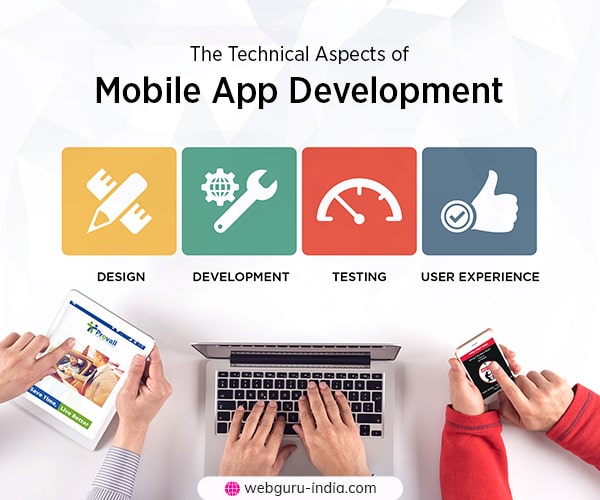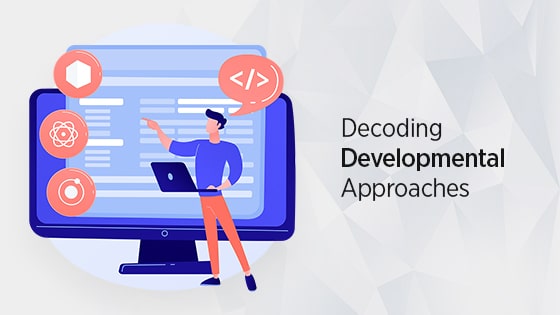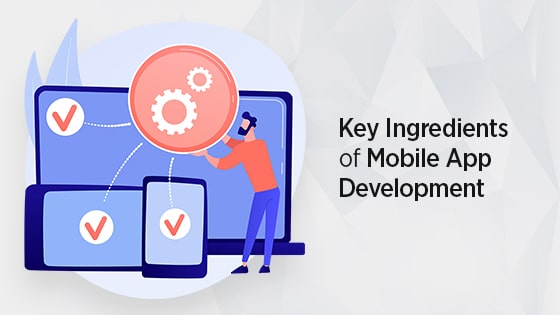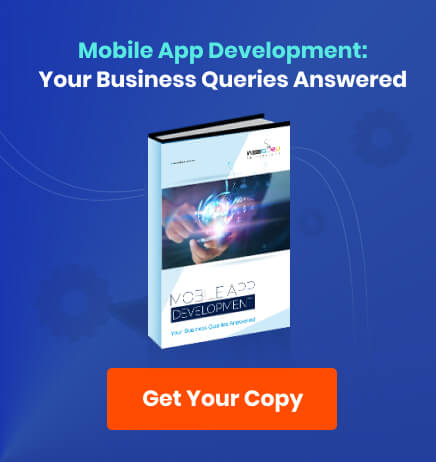Home Blog Mobile App Development Technical Insights into the Mobile App Development Process
Technical Insights into the Mobile App Development Process
- 25 Mar / 2021
- 3,282 views

It is 2021, and mobile apps continue to hold their sway among users and are rather growing at a rapid pace. Anyone would agree that apps have changed how people lead their lives in terms of communication, spending leisure time, and shopping online among others. But what does the popularity of mobile apps mean for businesses? As they run on all handheld devices, mobile apps allow businesses to reach more audience, boost brand loyalty, and drive conversions while offering unmatched on-the-go convenience.
But before you engage mobile app development services to get an intuitive and secure app, you may have a look at the fundamentals of the app-building process. Remember, a certain degree of technical know-how can help you make informed decisions, and that includes choosing the right app development company for your project. Curious to know more? Let us get started!
Device Platforms & Mobile Applications – What Do You Need to Know?
If you are planning to get an app for your business, the most urgent question to ask is which device platform you should build the app for – Android or iOS? You are most likely to have heard these terms, but let us understand them with greater clarity. While iOS is an operating system (OS) used by Apple to power its iPhone smartphones, Android is managed by Google and used in a variety of mobile phones manufactured by the OEMs.
Now, since the operating systems are different, building an app for each device platform requires implementing platform-specific languages, different Integrated Development Environment (IDE), and separate toolkits. For example, we use Objective C/Swift language for developing iOS apps, but we need to deploy Java (or Kotlin) -based Android SDK for building Android apps.
That apart, there is also another difference between iOS and Android we would like to point out. Apple has the exclusive right to use iOS for powering its smartphones, but Google has made Android available to other Original Equipment Manufacturers (OEMs) like Samsung, Xiaomi, Lenovo, and Oppo, on the condition that they equip their devices with certain Google applications.
Considering its wider compatibility with third-party devices, Android OS is being leveraged by several manufacturers today for creating affordable smartphones in countries like China, India, Brazil, France, and Germany. However, the picture is different in countries like the USA, Japan, Canada, and Sweden wherein iOS reigns supreme.
So, this is just a glimpse of the global mobile market share at present. We suggest you understand your target market first before deciding if you want an app for either Android or iOS or both.

Decoding Developmental Approaches for Mobile Applications….
Based on whether you want a platform-specific app or an app with cross-platform compatibility, the experts will pick the most suitable approach out of the four development methodologies. What are they? Let us find out.
- Native Applications
To put it simply, an app developed for a single platform is called a native application. The developers have to use frameworks and language supported by the platform to run the app on a specific operating system that is Android or iOS. In this regard, Objective C and Swift are used for creating iOS apps, while Java/Kotlin-based Android SDK is used for building Android apps. The choice of IDE also differs, for XCode is used for iOS and Android Studio with Android.
As native apps can directly access the operating system’s hardware resources such as a microphone, camera, and GPS, without requiring any third-party mediator like a library or container, they offer fast and friction-less performance while delivering a superior user experience.
However, native app development requires the developers to create codes for each platform, which may shoot up the time and cost of development. If you have both time and money, you should go for a native app because nothing can beat its fast performance and user-friendliness. Spotify, Twitter, and Lyft are some prominent brands that have notched up their brand success with native apps.
- Hybrid Applications
Want your app to run on multiple devices? Take a look at what a hybrid app has got to offer. So, these apps consist of codes written with standard web development technologies like CSS, HTML, and JavaScript. These codes are further wrapped in a native container using frameworks such as Apache Cordova.
Developing a hybrid app takes less time because it requires the common code base to build apps for both Android and iOS. Do you wonder if it is going to be as fast as a native app? Well, hybrid apps can imitate the look and feel of a native app, but they offer lower performance because these apps can access the native device features only through third-party containers like a web-view layer and not directly.
So, you see, when you are short on resources but want to deliver a close-to-native-like user experience, you can consider building a hybrid app. Some hit examples of hybrid apps are owned by BMW, Untappd, Sworkit, and Tencent. Feel free to take a cue from their work before planning your app strategy.
- Cross-Platform Applications
You may confuse cross-platform applications with hybrid ones, but there are differences between the two you should figure out. In this approach, the developers can utilise a range of frameworks for writing a single shareable code and then compile it into a native app, optimised for respective operating systems like iOS or Android. While frameworks like Xamarin and Flutter can compile cross-platform code into the native code, React Native offers native elements to work in sync with cross-platform codes.
This app option is certainly cheaper because writing and working on a single codebase requires less resources. Also, due to shared source-code, it gets easier to fix bugs and maintain the app in the long run. Impressed with the benefits? Contact the developers and get a robust cross-platform app for your business at the soonest!
But when compared to the hybrid applications, developing cross-platform apps can take more time, as the developers have to work on third-party libraries for accessing native device features. Once the cross-platform apps are developed, they can deliver near-native-like features, even though they can be bit sluggish in respect to smoothness or execution speed of native apps. Nonetheless, Evernote, Uber, HCL, and Xianyu by Alibaba have cross-platform apps that deliver a native-like user experience at reduced development costs.
- Progressive Web Applications
If you opt for PWAs, you get the best of both mobile apps and web technologies. Why? Written with web application technologies like CSS, HTML, and JavaScript, PWAs can be accessed through a browser but they add a link (icon, to be precise) on the home screen of the device to deliver the user experience of an app. That way, you don’t even have to download an app from the app store.
The best part is PWAs even work offline, giving the users tremendous flexibility to access information. Not only can they offer push notifications, but progressive web apps also boast of high loading speed, work smoothly on all devices, and help create a great user experience.
However, PWAs are Android-centric and do not support much of the other browsers. Although they are good alternatives to native apps, PWAs do not support native device features like phone cameras, GPS, and fingerprint scanner. Starbucks, Spotify and Uber have built PWAs, thereby paving the way for new technology standard in the realm of mobile app development.

Front-end and Back-end – Key Ingredients of Mobile App Development
Look, these terms may seem like indecipherable technical jargons at first but worry not, as we break them down for your understanding.
Basically, the front-end is what your users see on the mobile screen and interact with, while the back-end is the hidden part that controls and decides what appears on the front-end. The flow of information between these two core components is managed by the APIs. Not sure what an API is? We will talk about it in the following section, so let us understand the core components for now.
Simply put, the front-end contains the visual elements, delivering the ultimate user experience to the app users. Once the app gets downloaded, it resides on the mobile device and is identifiable by the app icon on the home screen or the mobile’s application catalogue. However, in the case of PWAs, the users need not download the app from the app store as they can access them through the browser and even add the icons to the home screen.
Depending on the scope of your app development project, there may be a number of developers involved in creating the front-end of the application. While UI designers create the app layout, graphic designers may design the visual elements like colours, icons, themes, and backgrounds. Remember, the more complex your project, the more resources will be required. This, in turn, will increase the costs, so it is suggested you sort your needs and resources before diving deep into the project.
Now, building a user-friendly front-end application is no doubt important, but without reliable back-end services, even the most ambitious mobile app development projects can fall flat. So, this is how it goes. Whenever the front-end receives an input from the user, the back-end, as the server-side code, processes the information and responds to the users’ requests. For example, when a user enters personal details on your app, the back-end is responsible for storing it in the database on the server to furnish it later whenever the user comes back to your app.
Back-end code? Database? Do they all sound too confusing and technical? Let us understand them this way. In the back-end, a set of codes running on the server, the high-powered computer, receives requests from the clients on the front end. Furthermore, the back-end architecture also contains the database, responsible for storing information and returning responses to the users’ queries. That’s the crux of the back-end applications.
When it comes to choosing the right technologies, the experts can select from a wide variety of server-side languages such as PHP, Node.js, Python, Erlang, ASP.Net/C#, Java etc. for the back-end development of your mobile app. That does not end there, for the app development team must also select an efficient database to ensure high-performance of the app and secure storage of data on the back-end. So, a top mobile app development company may choose from several options like PostgreSQL, MySQL, MS SQL, MongoDB etc. as the database for your app.
Considering you have understood what front-end and back-end are all about, are you curious to know what acts as the connector between the two? This is where APIs come into the picture!
Why Are APIs Called the Bridge between Front-end and Back-end?
So, what are the APIs? Application Programming Interfaces, also known as APIs, act as a communication protocol that facilitates easy interaction between two applications. In this case, the applications being front-end and back-end of mobile apps. In other words, we can call APIs the digital glue which connects a variety of systems or applications, thereby powering the digital business ecosystem of today. Typically, the back-end services can be accessed through APIs like REST and GraphQL to easily interact with the database in a mobile application.
Would you like to dig deeper into REST APIs? Here is a write-up you may want to read ‘Best Practices to Build RESTful APIs’.
Regarding the API integration in your mobile app, there are two options to choose from, first-party APIs and third-party APIs. Generally, the mobile app development team builds in-house APIs (first-party APIs) to have complete control over the design, lifecycle, and implementation of APIs. So that way, the experts can lay out the foundation of creating unique and secure mobile apps for their clients.
With that being said, we don’t mean third-party API integration is any less important. The app development team may use third-party integration for including additional services in an app. For instance, to integrate the geolocation or navigation in your mobile app, the developers can leverage Google Maps API. Likewise, they can also add social media APIs to integrate logins using social media data, thereby simplifying information sharing across platforms.
Overall, the app development team is the best fit to decide which types of APIs to integrate with your app.
Features and Functionalities – What to Add to Enrich Your App?
To put it straight, users have high expectations from mobile apps in terms of performance, usability, and reliability. Hence, adding certain features and capabilities to the app becomes essential, if you are to deliver value to the users.
After analysing the scope and requirements of your project, the app development team will decide what features and functionalities to add to your mobile app. In addition to the features for your core business need, the experts can add user engagement analytics, social media integrations, push notifications, live maps, and multiple payment gateways to help your app stand out from the crowd. You see, integrating features is specific to the type of app you build. The features of an M-commerce app will be very different from those of a messaging application.
Remember, mobile app usability is essential to deliver a great user experience, but its security will help you preserve user trust in the long run. After all, what is a great mobile app if it lacks security features? If you are to own a successful mobile app, remember that usability and security must go hand-in-hand. So, with this purpose in mind, the app developers will encrypt the obscure source code and use authorised SSL with APIs for ensuring your mobile app security.
Further, integrating machine learning techniques can boost your app with useful features like speech recognition, video & image recognition, and conversational chatbots. Overall, make sure you own an app that’s worth the time and attention of the users.
Final Thoughts
Developing a mobile app is a protracted process requiring you to make important considerations and informed decisions. We hope this blog serves as your quick guide for a successful mobile app building project. A little technical knowledge can definitely help you strategize better and set a successful action plan for your app development process. Wish you all the luck and success!
11 comments
Leave a Reply

-
1000+
Happy
Clients -
25+
Countries
Served -
19+
Years of
Trust








Superb explanation & it’s too clear to understand the concept as well, keep sharing admin with some updated information with right examples. Keep update more posts.
I’m glad to find another amazing app development blogger.
Thank you author for such a nice blog.Keep it up.
Thank you for sharing good information regarding Three Platform for mobile app and web apps It’s very easy to understand what you describe in this blog. Keep sharing such good information regarding Mobile and Web Development. This information is very helpful for me as a new Startup Company.
A well depicted topic on mobile app development services by Rajdip. The points on Native as well as hybrid applications are really outstanding.
Thanks, Very nice blog, and articles. I am really very happy to visit your blog I am impressed by the information that you have on this blog. Thanks for Sharing
Nice post.
A great piece that sheds much-needed light on IOS app development companies and its impact on the business as there are many new details you posted here. Sometimes it is not so easy to build a “iOS application development” without custom knowledge; here you need proper development skills and experience. However, the details you mention here would be very much helpful for the beginner.
Appreciable, I was searching for info like this for a long time! Keep those posts coming! Thanks for sharing
Thank you for sharing this with us !!
Waw!!! Fantastic post. You have done very excellent work. It’s an informative post. I got all things I was searching for. Thank you for sharing such a piece of meaningful information with us.